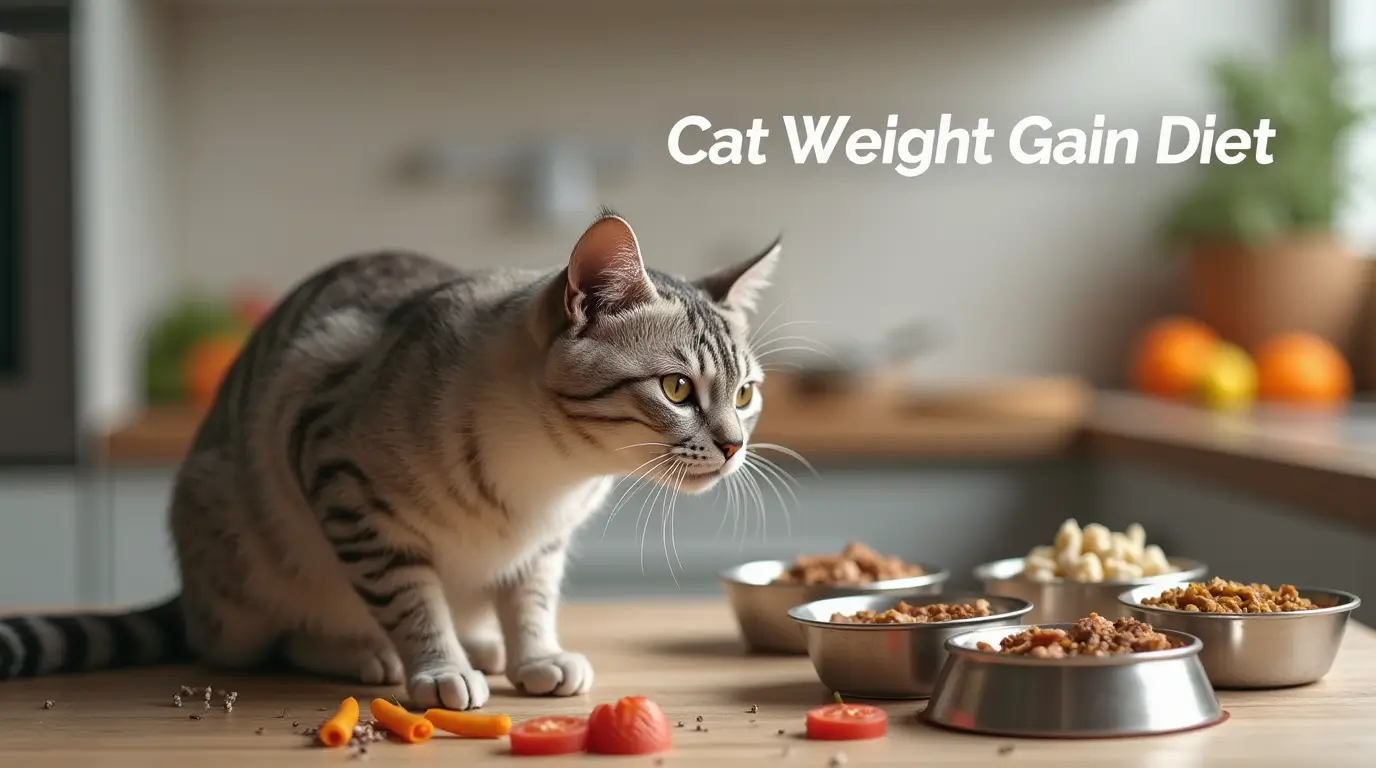Cat Weight Gain Diet: Top 6 Weight Gaining Foods for Cats
When you notice your beloved cat becoming increasingly thin, implementing a proper cat weight gain diet becomes crucial. It’s completely natural to feel worried – watching your feline companion lose weight can be distressing, especially when you’ve tried various foods without success.
Table of Contents
Your cat’s health is paramount, and maintaining a healthy weight plays a vital role in their overall well-being, immune system function, and energy levels. Whether dealing with a senior cat, a recent rescue, or a picky eater, understanding the right approach to weight gain can make all the difference. Let’s explore effective, veterinarian-approved ways to help your cat gain weight safely and sustainably through proper nutrition, feeding strategies, and carefully selected weight-gaining foods that your cat will actually enjoy.
Understanding Your Cat’s Weight Needs
Before diving into specific foods and recipes, you’ll need to understand what constitutes a healthy weight for your cat. Each breed has unique characteristics, and what’s underweight for one might be normal for another.
Signs Your Cat Needs to Gain Weight
- Visible spine and ribs
- Reduced energy levels
- Decreased appetite
- Dull or patchy coat
- Loss of muscle mass
Common Causes of Underweight Cats
- Dental problems
- Digestive issues
- Parasitic infections
- Stress or anxiety
- Recent illness
- Competition from other pets
The Top 6 Weight-Gaining Foods for Your Cat
1. Premium Protein-Rich Wet Foods
Your cat’s diet should primarily consist of high-quality protein sources. Premium wet foods often contain:
- Higher caloric density
- Better protein absorption
- Essential amino acids
- Natural moisture content
Recommended Options:
- Duck and turkey blends
- Salmon and mackerel combinations
- Chicken liver pâtés
- Kitten formulas (higher in calories)
2. Nutrient-Dense Natural Supplements
Incorporate these supplements under veterinary guidance:
- Fish oil (omega-3 fatty acids)
- Nutritional gel supplements
- Vitamin B complex
- Probiotics for better absorption
3. High-Calorie Dry Foods
Select premium kibble with:
- Minimum 30% protein content
- Healthy fat sources
- Added vitamins and minerals
- No artificial fillers
4. Digestive-Friendly Proteins
Focus on easily digestible protein sources:
- Cooked chicken breast
- Lean turkey
- White fish
- Rabbit meat
5. Caloric Dense Treats
Strategic treat options include:
- Freeze-dried meat treats
- Commercial weight gain treats
- Small amounts of plain cooked egg
- Bonito flakes
6. Specialty Formula Foods
Consider these specialized options:
- Recovery formulas
- High-energy dense foods
- Prescription weight gain diets
- Kitten formulas for adult cats
Homemade Cat Food Recipes for Weight Gain
Basic Protein-Rich Recipe
| Ingredient | Amount | Purpose |
|---|---|---|
| Lean chicken | 2 cups | Primary protein |
| Salmon oil | 1 tsp | Healthy fats |
| Egg yolk | 1 | Added calories |
| Taurine supplement | As directed | Essential nutrient |


Advanced Weight Gain Recipe
| Ingredient | Amount | Purpose |
|---|---|---|
| Turkey thigh | 1.5 cups | High-calorie protein |
| Liver | ¼ cup | Vital nutrients |
| Bone meal | 1 tsp | Calcium source |
| Fish oil | 1 tsp | Essential fats |
Creating an Effective Feeding Schedule
Morning Routine
- Small frequent meals
- Fresh water availability
- Warm food to enhance aroma
- Quiet feeding environment
Evening Schedule
- Larger portion before bedtime
- Mixed consistency foods
- Multiple feeding stations
- Fresh water refresh
Tips for Successful Weight Gain
- Monitor Progress
- Weekly weigh-ins
- Body condition scoring
- Progress photos
- Appetite tracking
- Environmental Considerations
- Stress-free feeding areas
- Easy access to food
- Clean feeding stations
- Multiple food bowls
- Feeding Techniques
- Hand feeding when necessary
- Food temperature optimization
- Texture variations
- Positive reinforcement
Common Challenges and Solutions
Picky Eaters
- Gradually introduce new foods
- Mix old and new foods
- Warm food slightly
- Try different textures
Slow Gainers
- Increase meal frequency
- Add healthy fat sources
- Consider appetite stimulants
- Adjust portion sizes
Frequently Asked Questions
Q: How long does it take to see weight gain results?
A: Typically, healthy weight gain takes 4-8 weeks with proper nutrition and feeding schedules.
Q: Is homemade cat food safe for weight gain?
A: Yes, when properly balanced with necessary nutrients and prepared following veterinary guidelines.
Q: Can I use kitten food for my underweight adult cat?
A: Yes, kitten food can be appropriate for weight gain in adult cats, but consult your veterinarian first.
Q: How often should I feed my cat for optimal weight gain?
A: Offer 4-6 small meals daily, adjusting based on your cat’s response and veterinary advice.
Expert Recommendations
Dr. Emily Warren, DVM, suggests: “Weight gain should be gradual and monitored. Rapid weight gain can stress your cat’s system and lead to other health issues.”
Dr. Michael Chen, Feline Nutritionist, adds: “The key to successful weight gain is not just increasing calories, but ensuring proper nutrient balance and digestibility.”
Conclusion and Next Steps
Your cat’s journey to a healthy weight requires patience, consistency, and attention to detail. Start with small changes, monitor progress closely, and maintain regular communication with your veterinarian.
Action Steps:
- Schedule a veterinary check-up
- Create a feeding schedule
- Start weight monitoring
- Implement dietary changes gradually
- Keep a progress journal
Remember, every cat is unique, and what works for one may not work for another. Stay attentive to your cat’s responses and adjust accordingly.
Would you like to discuss specific aspects of your cat’s weight gain journey? Share your experiences or concerns in the comments below.
References:
- American Association of Feline Practitioners
- Journal of Feline Medicine and Surgery
- Cornell University College of Veterinary Medicine
- The Ohio State University Veterinary Medical Center

